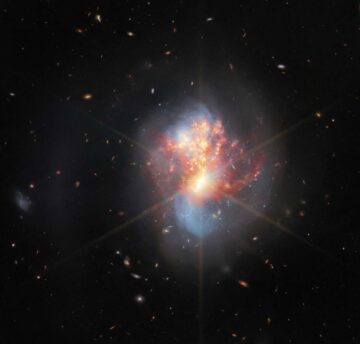Using a newly developed model for understanding the evolution of the Martian atmosphere, a new study suggests that Mars was born wet with a dense atmosphere allowing warm-to-hot oceans for millions of years. The model links the evolution of the Martian atmosphere with Mars’s formation in a molten state through to the formation of the first oceans and atmosphere.
The model shows that the water vapor in the Martian atmosphere was concentrated in the lower atmosphere, similar to how it is today on Earth, while the high atmosphere of Mars was “dry” because it would condense out as clouds at lower levels in the atmosphere. Contrarily, molecular hydrogen (H2) did not condense and was carried to Mars’ upper atmosphere, where it was lost to space.
This conclusion—that water vapor condensed and was retained on early Mars whereas molecular hydrogen did not condense and escaped—allows the model to be linked directly to measurements made by spacecraft, specifically, the Mars Science Laboratory rover Curiosity.
Kaveh Pahlevan, SETI Institute research scientist, said, “We believe we have modeled an overlooked chapter in Mars’s earliest history in the time immediately after the planet formed. To explain the data, the primordial Martian atmosphere must have been very dense (more than ~1000x as dense as the modern atmosphere) and composed primarily of molecular hydrogen (H2).”
“This finding is significant because H2 is known to be a strong greenhouse gas in dense environments. This dense atmosphere would have produced a strong greenhouse effect, allowing very early warm-to-hot water oceans to stabilize the Martian surface for millions of years until the H2 was gradually lost to space. For this reason, we infer that—at a time before the Earth itself had formed—Mars was born wet.”
The deuterium-to-hydrogen (D/H) ratio of various Martian rocks, including Martian meteorites and those studied by Curiosity, serves as the model’s primary source of data constraints. Deuterium is a heavy isotope of hydrogen. Most meteorites from Mars are igneous rocks; they were created when Mars’ interior melted and the magma rose to the surface.
The deuterium-to-hydrogen ratio of the water dissolved in these inner (mantle-derived) igneous rocks is comparable to that of the oceans on Earth, suggesting that the two planets initially had identical D/H ratios and that their water originated from the same source in the early solar system.
The model further shows that if the Martian atmosphere was H2-rich at the time of its formation (and more than ~1000x as dense as today), then the surface waters would naturally be enriched in deuterium by a factor of 2–3x relative to the interior, reproducing the observations. Deuterium prefers partitioning into the water molecule relative to molecular hydrogen (H2), which preferentially takes up ordinary hydrogen and escapes from the top of the atmosphere.
Pahlevan said, “This is the first published model that naturally reproduces these data, giving us some confidence that the atmospheric evolutionary scenario we have described corresponds to early events on Mars.”
Journal Reference:
- Kaveh Pahlevan et al., A primordial atmospheric origin of hydrospheric deuterium enrichment on Mars, Earth and Planetary Science Letters (2022). DOI: 10.1016/j.epsl.2022.117772













